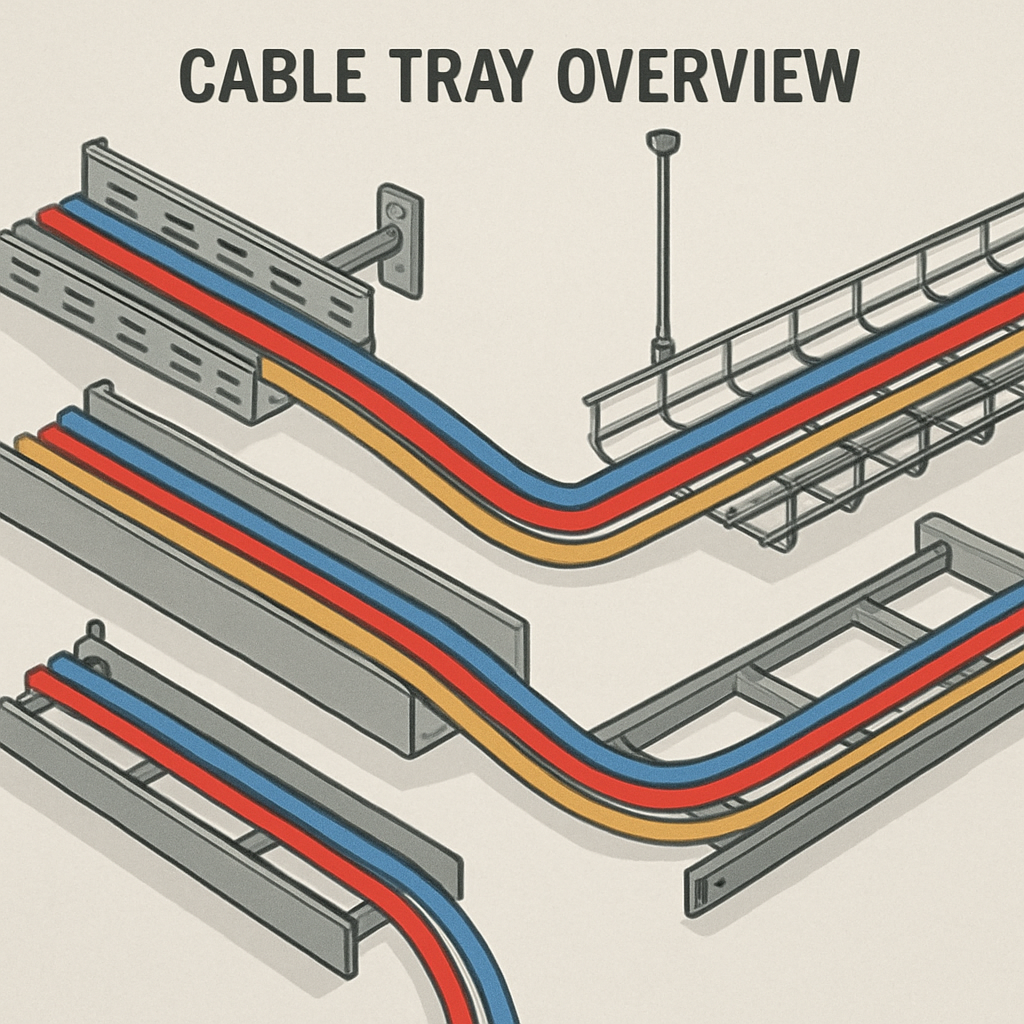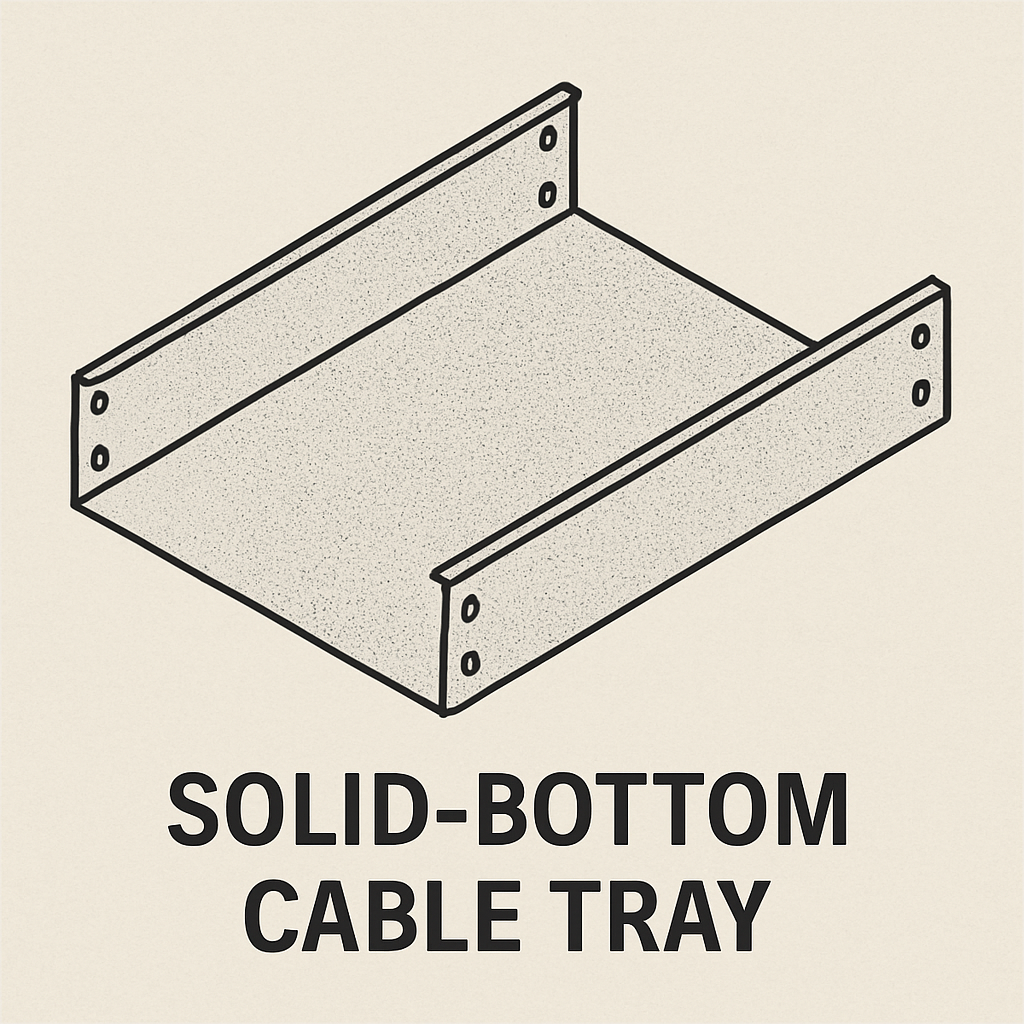In the realm of electrical installations and industrial wiring, cable trays play a pivotal role in ensuring efficient cable management systems. These systems are essential for maintaining organization and safety in environments where large numbers of cables are used. Whether you’re involved in a large-scale industrial project or a smaller commercial installation, understanding the different types of cable trays available is crucial. A well-chosen cable tray not only supports and protects cables but also simplifies future modifications and maintenance. This comprehensive guide will walk you through the various cable tray types, their applications, and why they are essential in cable routing and management.
Cable trays are structures used to support insulated electric cables. They provide a reliable method to route and manage cables across large distances in an orderly manner, preventing tangles and potential hazards. Cable trays not only provide support but also offer protection and simplify maintenance. Their design allows for easy access, making it simpler to inspect and modify cable systems as needed. They are a preferred choice in scenarios where changes to a wiring system are anticipated, as they allow for easy modifications. This flexibility is particularly valuable in dynamic environments where technology and configurations evolve rapidly.
Moreover, cable trays offer distinct advantages over traditional conduit systems. Unlike conduits, which can be cumbersome and difficult to modify, cable trays can be adjusted with minimal disruption. This adaptability is especially advantageous in environments that require regular updates or expansions, such as data centers, industrial facilities, and commercial buildings. By facilitating efficient cable management, cable trays contribute to enhanced safety, reduced downtime, and lower maintenance costs, making them a staple in modern electrical infrastructure.
Tipos de bandejas para cabos
Bandeja de cabos de fundo sólido
Solid bottom cable trays are one of the most commonly used types. They provide a continuous support surface for cables, which makes them suitable for cables that require protection from external contaminants. These trays are ideal for sensitive cables that cannot tolerate dust or other environmental factors. However, they require careful consideration of heat dissipation since the solid bottom can trap heat. To mitigate this, it’s important to ensure adequate airflow around the trays or consider integrating ventilation systems.
Solid bottom trays are frequently used in environments where cleanliness is paramount, such as pharmaceutical or food processing facilities. In these settings, preventing contamination is critical, and solid bottom trays offer the necessary protection. Despite their robust design, they can be customized to fit specific installation needs, offering versatility in various applications. Choosing the right material, such as galvanized steel or aluminum, can further enhance their durability and suitability for different environments.
Bandeja de cabos de malha de arame
Wire mesh cable trays, also known as basket trays, are made from a wire mesh structure. They are lightweight and highly adaptable, making them an excellent choice for data cables and other low-voltage applications. Wire mesh trays offer high ventilation, which aids in heat dissipation and prevents cable overheating. Their flexibility allows for easy cutting and bending, which is advantageous in complex routing scenarios. This makes them ideal for projects where space constraints or intricate pathways are a concern.
In addition to their flexibility, wire mesh trays are easy to install and modify, which can significantly reduce labor costs. They are often used in environments where rapid deployment is required, such as temporary installations or rapidly growing data centers. The open design also allows for quick visual inspections, enabling easier maintenance and troubleshooting. This accessibility can be a critical factor in environments where uptime is crucial, such as telecommunications and IT facilities.
Through Cable Tray
Trough cable trays are similar to solid bottom trays but have ventilated sides. This design provides better airflow while still offering ample protection from physical damage. Trough trays are often used in environments where moderate protection and ventilation are required. They strike a balance between solid bottom trays and ladder trays in terms of both protection and airflow. This makes them suitable for a wide range of applications, from commercial buildings to industrial plants.
The ventilated sides of trough cable trays help prevent the accumulation of dust and other debris, making them a practical choice for environments where cleanliness is important. Moreover, they offer a cost-effective solution for cable management, as they are typically less expensive than fully enclosed systems. The versatility of trough trays allows them to be used in conjunction with other cable management systems, providing a comprehensive solution for complex wiring needs.
Bandeja de cabos da escada
Ladder cable trays are characterized by their ladder-like design, with two side rails connected by rungs. This design allows for excellent airflow and heat dissipation, making them suitable for high-current cables that generate significant heat. Ladder trays are robust and can support heavy cables, making them ideal for industrial wiring and large-scale electrical installations. Their open design also allows for easy cable entry and exit, facilitating quick installations and modifications.
The durability of ladder cable trays makes them a preferred choice in environments that require heavy-duty support, such as manufacturing facilities and power plants. Their construction can handle substantial loads, reducing the risk of sagging or damage over time. Additionally, ladder trays are available in various materials, including steel and fiberglass, to suit different environmental conditions. This adaptability ensures that they can withstand harsh conditions, such as extreme temperatures or corrosive environments.
Esteira porta-cabos perfurada
Bandejas de cabos perfuradas feature holes or slots on the bottom and sometimes the sides. These perforations allow for good ventilation and drainage, reducing the risk of water accumulation. They are often used in environments where cables might be exposed to moisture or other liquids. Perforated trays are versatile and can be used for a wide range of cable types and applications. They offer a balance between protection and ventilation, making them suitable for various industries.
In addition to their functional benefits, perforated trays are often chosen for their aesthetic appeal. The design can be more visually appealing than other types of trays, making them a popular choice in commercial and office environments. The perforations also make it easier to secure cables, providing a neat and organized appearance. This can be particularly beneficial in settings where the cable management system is visible to customers or clients, reinforcing a professional and well-maintained image.
Choosing the Right Cable Tray
Selecting the appropriate cable tray for your needs involves considering several factors:
- Environmental Conditions: Assess the environment where the cable tray will be installed. Consider factors such as temperature, humidity, and exposure to chemicals or corrosive elements. The material and design of the tray should be chosen to withstand these conditions and ensure long-term performance.
- Cable Type and Weight: Determine the type and weight of the cables to be supported. Ensure the tray can handle the load and provides adequate protection and ventilation. Consider the future scalability of the installation to accommodate potential upgrades or expansions.
- Installation Flexibility: Consider the complexity of the cable routing. Some trays, like wire mesh trays, offer more flexibility for intricate paths. The ability to easily modify and expand the system can be a crucial factor in dynamic environments that require frequent changes.
- Maintenance and Accessibility: Think about how often you’ll need to access the cables for maintenance. Choose a tray that allows easy access if frequent maintenance is required. Easy access can reduce downtime and maintenance costs, contributing to overall operational efficiency.
- Cost and Budget: Evaluate the cost implications of each cable tray type. While some trays may have a higher upfront cost, they might offer better long-term savings through reduced maintenance and increased lifespan. Consider the total cost of ownership, including installation, maintenance, and potential upgrades.
Aplicações das Esteiras porta-cabos
Cable trays are employed in a variety of settings, each with unique requirements:
- Industrial Facilities: In industrial settings, robust trays like ladder trays are preferred for heavy-duty cables due to their strength and heat dissipation capabilities. They provide the necessary support for power distribution and control systems, ensuring reliability and safety in demanding environments.
- Commercial Buildings: Wire mesh trays are commonly used in commercial buildings for data cables, providing flexibility and easy installation. They are ideal for structured cabling systems, allowing for efficient management of network and communication cables.
- Chemical Plants: Perforated trays are ideal in environments where exposure to liquids is a concern, offering protection and drainage. They help prevent moisture accumulation, reducing the risk of cable damage and ensuring operational continuity.
- Offshore and Marine Installations: Solid bottom trays are often used in marine environments to protect cables from saltwater and other corrosive elements. Their robust construction ensures durability in harsh conditions, providing reliable cable management for critical operations.
Installation and Maintenance of Cable Trays
Proper installation and maintenance are crucial to the effectiveness and longevity of cable tray systems:
- Installation Tips: Ensure that trays are securely mounted and supported to prevent sagging. Follow manufacturer guidelines for spacing and support to maintain structural integrity. Proper planning and execution during installation can prevent future issues and ensure optimal performance.
- Regular Inspections: Conduct routine inspections to check for any signs of wear, corrosion, or damage. Address any issues promptly to prevent further deterioration. Regular inspections can also identify potential safety hazards, allowing for timely interventions.
- Cleaning and Upkeep: Keep trays clean and free from debris to ensure optimal airflow and performance. Regular cleaning also helps in spotting potential issues early. Implementing a routine maintenance schedule can extend the lifespan of the cable tray system and improve overall efficiency.
Conclusão
Cable trays are an integral part of any electrical installation, offering a structured and efficient way to manage cables. By understanding the different types of cable trays and their applications, you can make informed decisions that enhance the safety, efficiency, and longevity of your cable management system. Whether you’re installing new cables or upgrading an existing system, choosing the right cable tray type is essential for successful cable management.
By considering the factors discussed in this guide, you can confidently select the best cable tray for your specific needs, ensuring a reliable and effective cable management solution. A well-chosen cable tray system not only supports current requirements but also provides flexibility for future growth and changes, making it a valuable investment in any electrical infrastructure.



